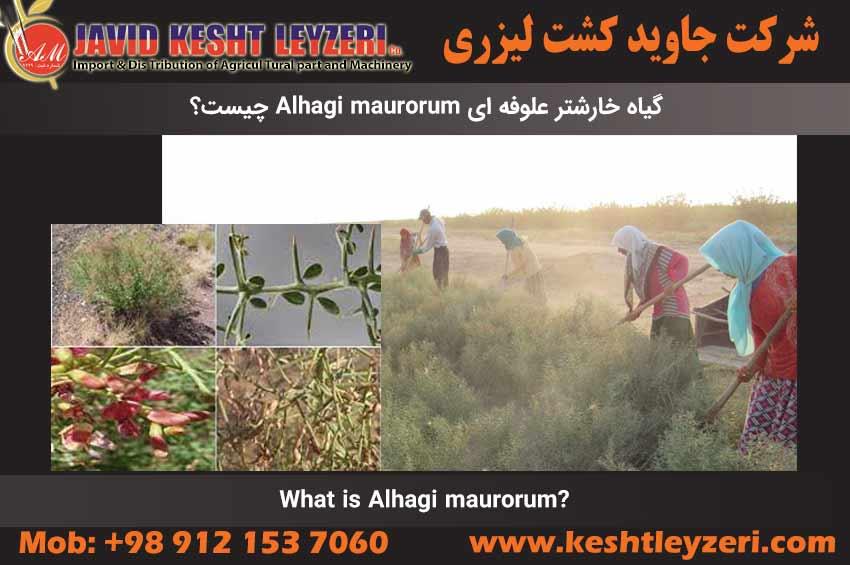
What is Alhagi maurorum?
javid keshtleyzeri Co.ltd
List of contents of this section:
What is scabies plant and how many species are there?
Is the scabbard plant a fodder plant and suitable for animal feeding?
What is the nutritional value of the scabbard plant for animal feed?
What characteristics are needed for the growth of a scabious plant?
What is the best time to harvest scabies?
What kind of livestock and birds is Khaxter fodder suitable for?
What is the use of scurvy fodder in feeding livestock?
In the following, the above contents will be reviewed.
What is scabies plant and how many species are there?
There are different species of scabter plant in the world, but two species are common in Iran. The scientific name of this plant is Alhagi maurorum and it has spread natively in our country. This plant is known as a bush or small permanent shrub with many thorns. It has many green branches, small leaves, and flowers similar to other plants of the legume family.
At the time of initial flowering, sedge has the highest quantity and quality and is considered a good source of nutrition for many ruminant animals. This plant has been used since ancient times as a medicinal plant of mangroves, itchy sweat, camel fodder, and light livestock fodder. Also, as one of the important weeds in fields, orchards, wetlands, residential areas, airports, and roads, especially in hot and dry areas, it has special attention.
Kharster is native to the Mediterranean and West Asia regions and can be found in Iran from sea level to 4000 meters. This plant is scattered in hot and dry areas, especially on the edge of the deserts of Razavi Khorasan, South Khorasan, Yazd, and Isfahan. The propagation of this plant is done through seed production and rhizome growth. The seeds germinate in the soil temperature close to 20 degrees Celsius in early spring, if moisture is present and help the seedlings to grow well.
Is the scabbard plant a fodder plant and suitable for animal feeding?
The scabbard plant is used as a fodder plant for animal feed. Due to its characteristics, including leafy vegetables, abundant branches, and abundant flowering, this plant is considered as an important and good source of nutrition for livestock.
It is suitable for light livestock such as cows, camels and sheep and is often used as a part of their diet in dry and hot regions. Due to its resistance to dry conditions and poor soils, this plant is highly valued in areas with limited water resources.
Also, scurvy is used as an important weed killer plant in the control of weeds in fields and other agricultural areas.
Researches conducted in some parts of the world, including China and Australia, show that the scabbard plant has a favorable talent in terms of fodder production. With low water consumption and high tolerance to salinity, this plant has the ability to produce quality fodder free of limiting substances for livestock. An important point is that sorghum is one of Iran's pasture plants, which has been used as livestock feed since the past, and during the flowering season, ranchers used it as a reliable food source for light and even heavy livestock. In areas such as South Khorasan, Kerman, Yazd, and desert areas of Isfahan province, the use of fodder from this plant is considered as a common protein.
What is the nutritional value of the scabbard plant for animal feed?
The nutritive value of horseradish for livestock feed varies according to growing conditions, stage of plant growth, and farm management. But in general, sorghum is an important source of nutrition for livestock, especially in arid and water-deficient areas.
The characteristics of the nutritive value are:
Protein: sorghum has a significant amount of protein, which can serve as an important protein source for livestock.
Fiber: The presence of fiber in the krachter can help improve the digestion of animals.
Mineral elements: The scurvy plant contains mineral elements such as calcium, phosphorus, potassium and copper, which are essential for the health of animals.
Vitamins: The presence of various vitamins, including vitamin C, provides the nutritional needs of livestock.
It is important that these values change with seasonal changes, plant growth stage, and environmental conditions. In any case, sorghum is valid as a valuable food source for livestock, especially in areas with limited water resources.
Tests conducted globally and in Iran show that the nutritional value of the scabbard plant as animal feed is comparable to the average quality of alfalfa fodder and may even exceed it. Chemical analyzes and information related to plant nutrients in different stages of growth show that this plant has a significant amount of protein and even more phosphorus than hay. Also, the percentage of organic matter and raw fibers is similar to hay. The obtained information shows that khashter also has significant digestibility.
The amounts of crude protein, crude fat, crude fiber, and crude ash in the forage of Khastar at the time of seeding are 8.28, 9.2, 8.7, and 9.9% in dry matter, respectively. But in the flowering stage, the amount of crude protein has decreased to a percentage. In addition, there is the property of ensiling of khashter fodder and the acidity of khashter silage is 4.6 and the amount of dry matter and crude protein is 47.2 and 25.7%, respectively.
The nutritional value of the scaber plant decreases with the passage of time; The amount of soluble carbohydrates in it decreases and its relative value increases in spring compared to summer. This relative value increases from 1.46% in April to 3.43% in April. Also, in July it reaches 39% and with a decreasing trend until September it reaches 3.36%.
In a study in which dry scurvy plant was used as a substitute for hay and wheat straw in the feeding of male and female goats, the adverse effect on fat intake
Thus, daily weight gain and food conversion ratio were not observed in both sexes.
In another study, when sorghum plant replaced alfalfa and wheat straw in the diet of ewes, daily dry matter and crude energy intake did not change in ewes. However, postpartum weight and lamb weight did not change. In goats, the consumption of dry matter and raw energy decreased with the increase in the level of scabies, which led to a decrease in the weight of the goats.
In another study, dry grass was used instead of wheat straw and alfalfa in the diet of pregnant and lactating ewes. This change led to an increase in daily milk production, although fat, protein, and milk solids decreased. Also, the daily weight gain of lambs born to mothers fed scabies grass was lower. The use of sedge grass reduced the cost of feed. It seems that itchy grass can meet the maintenance, pregnancy, and lactation needs of sheep. When sheep were fed scabies grass, the sheep consumed this dried and chopped plant better and more easily than fresh grass or scabies silage. It was also shown that the dry grass has a longer shelf life than its silage and can be used in the winter ration of livestock.
What characteristics are needed for the growth of a scabious plant?
During the entire growth period, skharster needs sunny, warm, and dry air conditions with optimal temperatures of 20 to 35 degrees Celsius. Cultivation and growth of this plant based on its natural distribution is possible in most places with hot and dry climate, even in humid and salty coastal areas such as the shores of the Caspian Sea in Gonbad city. Scabies natural growth has been observed in hot and dry stages, even at temperatures around 40°C or higher. In areas with cold winters, scabies growth slows down and stops for several months.
Due to the thickness of the seed shell, scabter has a physical dormancy, which is broken by scratching the shell or washing with sulfuric acid, and seed germination is provided. According to research, placing the seeds in 96% sulfuric acid for 20 to 25 minutes breaks the seed dormancy, and then the seeds are washed. Scratching the seed coat and placing the seeds in water at a temperature close to 100 degrees for 3-4 minutes induced up to 60% of the seeds to germinate. Based on the results of the research, the use of sulfuric acid or the method of scraping the seed shell is recommended as more effective methods to cause the failure of seed dormancy.
What is the best time to harvest scabies?
The harvesting time of the scaber plant may vary depending on the intended purpose and use. Overall, harvest time can have an important effect on nutrient quality and quantity. Below are some things that may be important at harvest time:
Flowering:
In order to obtain the best quality, it is better to harvest the scabbard during the flowering stage. At this time, the concentration of nutrients is higher and the quality of forage is better.
Growth stage:
Depending on the intended use, the growth stage of the plant is also influential. For foragers, the best time may be during the budding or pre-flowering stage.
Weather and temperature conditions:
Harvesting in dry and sunny times can increase the quality of fodder. On the other hand, if the weather gets too hot, forage quality may decrease.
Usage context:
If the plant is used as fodder, harvesting time may also depend on individual limitations. For light livestock, it may be better to harvest at the germination stage.
In general, observing and monitoring the growth stages of the plant, weather and temperature conditions, and the ultimate purpose of using the plant can determine the best time to harvest.
The best time to harvest this forage to obtain the highest quality is usually in the middle of the flowering stage or when about 50% of the plant has flowered. At this time, the protein content is around 11-12% and the dry matter is around 35%. After harvesting, this fodder product is chopped and used as fodder due to indigenous knowledge.
What kind of livestock and birds is Khaxter fodder suitable for?
This forage can be turned into pellets and is very suitable for feeding ruminants, ostriches, and even laying hens. In desert areas, this fodder may be used directly for camel and goat herds.
Forage is considered as a useful source of nutrition for several types of livestock and birds. This fodder is suitable for light and heavy livestock as well as some birds. Below are the cases for which scratcher fodder is suitable:
Cows:
Cattle forage can be used as an excellent source of protein and nutrients. This plant is especially suitable in dry and low water areas.
Camels:
Camels can also use scraper fodder as a part of their diet. This plant is suitable due to its resistance to dry conditions and the edge of the desert.
Sheep and calves:
Forage for sheep and calves is also considered as an important source of nutrition.
Egg-laying birds:
Some laying birds can also benefit from scraper forage. This plant can be suitable for birds due to its nutritional properties.
ostrich:
Forage can also be an important source of nutrition for ostriches.
It is important that in each case, the quantity and manner of consumption of scraper fodder is carefully examined to ensure that the feeding of the animal or bird is carried out efficiently.
What is the use of scabbard fodder in feeding livestock?
Dry and chopped forage or silage can be used as an important component in feeding ruminants, especially goats and sheep. in sheep feeding
Dried and crushed horseradish is not only better accepted than silage, but also has a longer shelf life.
To prepare rougher silage, it can be chopped into 1 to 2 cm pieces and silated for 70 to 90 days by adding 5 to 10 percent of molasses or waste dates to the amount of dry matter.
The use of krachter silage can be useful as a high-quality feed source for feeding sheep and other livestock in times of forage scarcity.
Dry and chopped forage can completely replace the fodder part of the feed in the ration of sheep and goats, up to 100%.






